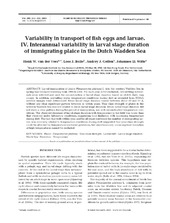Variability in transport of fish eggs and larvae. IV. Interannual variability in larval stage duration of immigrating plaice in the Dutch Wadden Sea
Peer reviewed, Journal article
Published version
Permanent lenke
http://hdl.handle.net/1956/6601Utgivelsesdato
2009-09-18Metadata
Vis full innførselSamlinger
Originalversjon
https://doi.org/10.3354/meps08176Sammendrag
Larval immigration of plaice Pleuronectes platessa L. into the western Wadden Sea in spring was followed biweekly from 1993 to 2002. For each year (1993 excluded), 150 settling individuals were selected and used for reconstruction of larval stage duration based on otolith daily ring counts. In addition, prevailing water temperature conditions during drift as revealed from NOAA satellite images were determined. Mean larval stage duration varied between about 40 and 60 d, without any clear significant pattern between or within years. Year-class strength of plaice in the western Wadden Sea was not related to mean larval stage duration. Mean larval stage duration did not show a clear pattern during the period of immigration, nor with reconstructed temperature conditions. The observed decrease of larval stage duration with temperature in the field was lower than that observed under laboratory conditions, suggesting food limitation with increasing temperature during drift. The fact that both within-year and for all years combined the number of immigrating larvae was inversely related to temperature conditions during drift suggested that year-class strength could be affected by temperature-mediated predation, but simultaneously occurring food limitation at high temperatures cannot be excluded.
